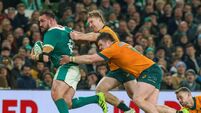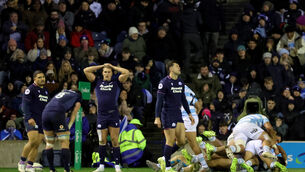Black ops
While Munster have been fine-tuning their game plan for Saturday's clash in Cardiff's Millennium Stadium, under the reassuring leadership of coach Alan Gaffney, his opposite number at the Gnoll, Lyn Jones, seems to have been struggling to keep his players focused amid talk of buy-outs, mergers and, worst of all, confused ownership.
Neath RFC, it appears, are not owned by whom they thought they were. The astonishing news was dealt to club chief executive Mike Cuddy, the club's main sponsor, as he was preparing to finalise his takeover of the club last week from the Welsh Rugby Union. Trouble was, it was not the WRU's to sell.
The game's governing body in the principality only controlled the players' contracts while the club's grounds and facilities still belonged to the club's old committee. When the WRU assumed control of the club in order to keep it afloat, they did so without assuming the debts of the old regime and set up a new company called Gowerpark. But the WRU, through Gowerpark, did not complete the purchase, leaving the old guard still in control of everything save for the players.
Which means the prospective new owner has to stop buying the club from the WRU and go back to the drawing board.
"There's a kind of Old Neath and a New Neath at the Gnoll," explained journalist Simon JA Jones, who contributes to the entertaining and thoroughly independent Welsh rugby website Gwladrugby.com.
"The WRU took over the running of the club but didn't want to take over the debts of the old committee. So they set up a new company called Gowerpark which ran Neath RFC but without legally owning any of the assets except for the player contracts.
"So at the moment, nobody's quite sure of the exact legal status of who owns what or whether there is any legal basis to Mike Cuddy's attempts to buy the club as a whole. Everything's up in the air and it's very confusing for the fans."
What further muddies the waters for Neath's fans is the fact that from next season there is every possibility there won't be a Neath at all. With the WRU in financial crisis, new chief executive David Moffett has been charged with the task of finding a more viable way for Welsh clubs to compete in the professional game. The alternatives include Moffett's four-provinces blueprint to be approved, whereby the Welsh All Blacks would merge with Bridgend as a West Wales outfit, or the alternative five-team plan put forward by the other premier clubs, which would forced Neath into a merger they don't want with arch-rivals Swansea.
Simon Jones of Gwladrugby.com gwlad means homeland in Welsh believes the Neath-Swansea proposal is a definite non-starter. "Swansea are their natural enemies and merging the two would be like trying to merge Celtic and Rangers into a single Glasgow side. The fans would go ballistic."
Not that a merger particularly lights anyone's fire in Neath in the first place.
"I think more Neath fans would be happier with a provincial-style solution," Jones added, "a West Wales team which would bring on board all of the clubs."
The Celtic League final, then, is proving to be a welcome distraction for fans of the oldest club in Wales. Formed in 1871, the club's founding players wore dark jerseys until an all black strip was adopted nine years later, so the legend has it, as a mark of respect following the death of one Dick Gordon from injuries sustained during a match against Bridgend.
The club's famous white Maltese Cross was introduced, says club historian Mike Price, by a half-back by the name of E C Moxham, who turned up one day with a cap bearing the insignia as a means to "break up the monotony of the dark garb".
That dark garb has become one of the cornerstones of Welsh club rugby in the ensuing 123 years as Neath have had a habit of being inaugural winners, of the Welsh Challenge Cup, the Welsh League and, just last year, the Welsh Under-21 Cup. According to Jones, the success has always come against the odds.
"Neath always have had less resources," says the Gwlad man. "If you think back to the late 1980s and early 1990s, the club was winning the Welsh championship, producing a lot of great talent like Allan Bateman and so on and was having those unofficial battle of Britain matches with Bath to see which was the best club in the UK. But they didn't have very much money, even then. A bit like Munster I suppose, perceived to be greater than the sum of its parts. It was team spirit that got them further than they should have.
"When Neath coach Ron Waldron took over as Welsh coach, Wales went on tour to Australia and he took a lot of Neath players with him. The squad ended up hopelessly divided between Neath and non-Neath. It's been held up for ever more as an example of why you should never pick so many players from one club. Ever since, we've been under represented in relation to the successes of the club although perhaps not in terms of individual ability.
"As a pack our forwards have stood up very well this year, certainly against all the Welsh opposition and also against the likes of Leicester at home. And yet only old warhorse Gareth Llewellyn has been called into the Wales squad. Neath are a better unit than they are individually."
This weekend, the Welsh All Blacks continue to set the trend by becoming the first Welsh club to appear in the Celtic League final, and the feeling is that, well, anything could happen. This season has been all peaks and troughs, a home Celtic League pool defeat to Munster followed up by a valiant Heineken Cup draw at the Gnoll against champions Leicester. Then a victory over Pontypridd at Sardis Road to reach the last four of the Celtic League which preceded a humiliating defeat in Italy to Heineken Cup minnows Amatori & Calvisano. It's difficult even for seasoned Neath watchers to put a finger on where this team is at.
"In the early days of the season a lot of people were saying Neath weren't as good as they were last season," Jones said.
"They'd beaten Munster in the Celtic League in 2001 but lost at home to them in the Celtic League this time round. But the club had brought in players like Adrian Durston at full-back, Lee Jarvis at out-half and Hywel Jenkins at blindside flanker. We'd become a buying club for the first time but something didn't quite seem to be gelling.
"They are arguably better now and when there is a full team out they have looked formidable. They just seem to me to be a bit wary of the big match occasion, particularly away, outside Wales, where they've looked dreadful. It would be pretty amazing if they won the Celtic League without having beaten a non-Welsh team outside of Wales."
And yet, Neath fans will travel to Cardiff in confident mood. They know no other way, says Jones. "You don't often hear Neath supporters saying they are going to lose any game. Even going to Leicester a couple of weekends ago, the fans were saying we would beat them at Welford Road. But then Neath fans possess an incredibly one-eyed, self-opinionated view. It dates back to the late 1980s when they refused to give anybody any respect whatsoever and trampled over sides all around Wales. Having said that, if you look at the Celtic League final with any sort of dispassionate view, the way Munster played against Gloucester means most of us are just hoping for a great game. And secretly, a lot of Neath fans will be hoping it's not a rout.
"Finals rarely tend to be, though, they tend to be a lot closer and we are, "at home", so it's a bit of a day out to. Our average level of support is around 7,000 at the Gnoll but for this final I think it will be a case of somebody turn the lights out as you leave Neath.
"They'll try desperately to paint the stadium black but they'll have to rely on other fans from Wales getting behind Neath against non-Welsh opposition. You would get a lot of neutrals who would consider Neath to be their second team. They try and play attractive rugby and in marketing parlance the All black is a strong brand. Sure, you'll get a few people being anti-Neath, but on the whole most of Wales will be rooting for Neath.
"In theory, with Neath in the Celtic League final, Llanelli still in the Heineken Cup and Pontypridd still in the Parker Pen, you could end up with Welsh clubs winning three cross-border competitions. And if that happens, the people who want a club-based future in Wales will be delighted.
"Most fans are aware we're not a city club like Cardiff or Swansea, nor do we have the same level of provincial support that Llanelli might get so the chances are we're going to have to merge or become part of a province next year. In which case, this is it, let's go out with a bang. This is about us wanting to prove ourselves to the other clubs and to the rest of the world."
15 Paul Thorburn
Rescued Wales from embarrassment with his steam-piston kicking on several occasions in the late 80s and early 90s, amassing 304 Test points in the process. Kicked the winning goal against England to take Wales into the semi-finals of the 1987 World Cup.
14 Dan Jones
Scored a world record 59 tries in the 1928/29 season to help Neath to the Welsh Championship
13 Allan Bateman
One of the great Welsh centres of all time, Neath's prodigal son has returned to the Gnoll for a second spell after a glittering career in League for Warrington, the Corunulla Sharks and Great Britain as well Northampton Saints and the British and Irish Lions.
12 Scott Gibbs
Like Bateman, Gibbs has enjoyed a successful career in both Union and League, including a League Challenge Cup Final medal and three Lions tours. Now in a second stint at Swansea, Gibbs will be remembered forever in Wales as the scorer of the match-winning try against England at Wembley.
11 Elgan Rees
A double Lion in 1977 and 1980, Elgan kept Welsh pride alive as the golden era of the 1970s flickered out.
10 Jonathan Davies
Perhaps the greatest Welsh number 10 since Barry John. The 1988 Triple Crown was probably Davies greatest moment in Union before he crossed codes. Won GB honours in League as Wales and the Lions missed out on the best years of the finest rugby player of his generation. Now a media pundit.
9 Martyn Davies
Captain of Neath when they won the first Welsh Cup in 1972, and captain throughout the early 1970s.
Martyn was a terrific servant to the club at a time when Wales had world-class scrum-halves falling out of trees.
1 Courtney Meredith
A fine prop, toured South Africa with the Lions in 1955
2 Cliff Williams
Captained the club to the first post-war Welsh championship in 1946/47
3 Ron Waldron
Neath's greatest prop, Waldron's earned just four Wales caps, in the Triple Crown season of 1965. He went on to coach the club with great success in the late 1980s, before coaching Wales with markedly less success in 1991.
4 Gareth Llewellyn
One of Neath's all-time greats and capped a forwards' record 64 times by Wales. Best remembered for the two lineout steals which helped to beat France in 1996 but during his two spells at Neath, Llewellyn has led by example.
5 Roy John
The Prince of lineout play, Lion Roy John is a Neath legend. Edged it over Rees Stephens.
6 Phil Pugh
Only played once for Wales but a massive servant to the club during their invincible era of the late 1980s.
7 Brett Sinkinson
Will probably be forever tarnished by the Kiwigate scandal which exposed his ineligibility for Wales, but he played his heart out like a true Welshman before they caught up with him, helping them to improbable victories against South Africa, France, England and Argentina.
Now qualifies for Wales through residency, and not his Nan, who wasn't born in Wales, but did once buy a second-hand Nissan Micra from Slater's of Abergele.
8 Dai Morris
Played blind-side flanker for Wales in the late 1960s and early 1970s, but Lions tourist Morris was a solid Number 8 for Neath. Played 34 times for Wales between '67 and '74, scoring two tries against Australia in the process.















